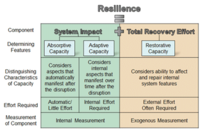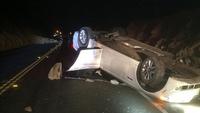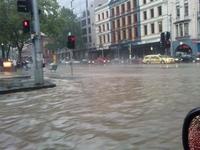-
A grid of the right size could reduce blackout risk
Scientists argue that for every animal there is an optimal size — one which allows it to make best use of its environment and the physical laws that govern its activities, whether hiding, hunting, hoofing, or hibernating. Now, researchers are asking whether there is a “right” size for another type of huge beast: the U.S. power grid. The researchers believe that smaller grids would reduce the likelihood of severe outages, such as the 2003 Northeast blackout that cut power to fifty million people in the United States and Canada for up to two days.
-
-
Landscape shifts may influence where tornadoes touch down
Areas where landscape shifts from urban to rural or forest to farmland may have a higher likelihood of severe weather and tornado touchdowns, a new study says. An examination of more than sixty years of Indiana tornado climatology data from the National Weather Service’s Storm Prediction Center showed that a majority of tornado touchdowns occurred near areas where dramatically different landscapes meet — for example, where a city fades into farmland or a forest meets a plain.
-
-
Bangladesh tops list of countries at risk from sea level rise
Scientists say that see levels may rise by up to the feet by 2100.The implications of this would have drastic consequences for nearly all coastal nations, but the consensus is that Bangladesh will be the hardest hit by the change. Leading Bangladeshis say that since Bangladesh produces less than 0.3 percent of the emissions driving climate change, it would unjust for Bangladesh to rely on its own meager resources to solve this problem. One solution they offer: fifty million Bangladeshis (out of a population of 163 million) should be allowed to move to and resettle in the countries which produce the bulk of greenhouse gasses.
-
-
Coalition sounds alarm about possible global EMP disaster
A coalition that includes former speaker of the House Newt Gingrich and former CIA director James Woolsey has issued a terse warning regarding apocalyptic effects that could result from a mass EMP (electromagnetic pulse) disaster or attack. Members of the coalition “are convinced that our fragile electrical grid could be wiped out at any moment” from bursts of electrical energy caused by anything from a nuclear explosion to a solar flare from the sun, leading to chaos on a global scale.
-
-
Sandia to help cities be better prepared for, emerge stronger from, disasters

Sandia National Laboratories says it will bring its experience solving problems with practical engineering and modeling complex systems to cities around the world under a new agreement to support the 100 Resilient Cities Centennial Challenge, pioneered by the Rockefeller Foundation. The challenge, which will help thirty-three cities in its first year, seeks to make communities more resilient by being better prepared to withstand natural or manmade disasters, recover more quickly, and emerge stronger.
-
-
Roadmap outlines R&D path to reduce storm impacts
A new measurement science research and development (R&D) roadmap, prepared for the National Institute of Standards and Technology (NIST) over the past two years by a private-sector group of hazard mitigation experts, provides a broad strategic approach and R&D objectives to reduce impacts from windstorms and coastal inundations, including storm surge during hurricanes and tsunamis.
-
-
Friday L.A. tremor harbinger of quake worse than the Big One

Seismologists warn that a bigger earthquake along the Puente Hills fault, which produced the 5.1 magnitude tremor in Los Angeles last Friday, could cause more damage to the region than the anticipated “Big One” from the San Andreas Fault located on the outskirts of metropolitan Southern California. A 7.5-magnitude earthquake along the Puente Hills fault could kill 3,000 to 18,000 people and cause up to $250 billion in damages, leaving up to 750,000 people homeless. In contrast, an 8-magnitude earthquake along the San Andreas Fault would result in about 1,800 deaths.
-
-
Global insured losses from catastrophes were $45 billion in 2013
Total economic losses from natural catastrophes and man-made disasters were $140 billion in 2013. Global insured losses were around $45 billion in 2013, with large contributions from flooding and hail events. The economic losses of $140 billion were down from $196 billion in 2012, and below the 10-year average of $190 billion. Around 26,000 lives were lost in natural catastrophes and man-made disasters in 2013.
-
-
NIST issues final Joplin tornado report
The National Institute of Standards and Technology (NIST) has released the final report on its technical investigation into the impacts of the 22 May 2011 tornado that struck Joplin, Missouri. The massive storm was the single deadliest tornado in the United States in the sixty years that official records have been kept. The NIST Joplin tornado study was the first to study scientifically a tornado in terms of four key aspects: storm characteristics, building performance, human behavior, and emergency communication — and then assess the impact of each on preventing injury or death.
-
-
Conflicting views hamper N.C. preparation for sea level rise
Residents of North Carolina’s coastal towns are finding themselves increasingly caught in the cross-fire between local and state government regarding how to define future sea level rise resulting from global warming and the necessary measures needed to prepare for it. Due to a four-year moratorium on any action on the state level, area developers and homeowners have received no official input, and the lack of consensus has negative consequences for the health and prosperity of the region.
-
-
Southeast England residents most at risk of rising deaths from climate change
Warmer summers brought on by climate change will cause more deaths in London and southeast England than the rest of the country, scientists predict. Researchers looked at temperature records and mortality figures for 2001 to 2010 to find out which districts in England and Wales experience the biggest effects from warm temperatures. In the most vulnerable districts, in London and the southeast, the odds of dying from cardiovascular or respiratory causes increased by over 10 percent for every 1C rise in temperature.
-
-
Ground-improvement methods to protect against earthquakes
Researchers are developing ground-improvement methods to help increase the resilience of homes and low-rise structures built on top of soils prone to liquefaction during strong earthquakes. Findings will help improve the safety of structures in Christchurch and the Canterbury region in New Zealand, which were devastated in 2010 and 2011 by a series of powerful earthquakes.
-
-
Climate change, population pressures leading to rethink of floating cities

The concepts have existed for decades, but governments and financiers, responding to the growing threat of rising tides, pollution, and overpopulation to coastal urban centers, are now beginning to take a more serious look at floating cities.
-
-
HHS proposes rules to govern health-care facilities’ disaster preparedness
The Centers for Medicare and Medicaid Services(CMS), a federal agency within the Department of Health and Human Services, has proposed new requirementsfor health-care facilities intended to ensure these facilities are prepared to care for patients during disasters. The regulations aim to prevent the service disruptions which occurred during Hurricane Sandy and Hurricane Katrina, when an estimated 215 deaths occurred in hospitals and nursing homes in Louisiana.
-
-
Linking extreme weather events to climate change a “distraction”: experts

Connecting extreme weather to climate change distracts from the need to protect society from high-impact weather events which will continue to happen irrespective of human-induced climate change, say experts. They suggest that developing greater resilience to extreme weather events must be given greater priority if the socioeconomic impact of storms, like those that have ravaged Britain this winter, is to be reduced.
-
- All
- Regional
- Water
- Biometrics
- Borders/Immig
- Business
- Cybersecurity
- Detection
- Disasters
- Government
- Infrastructure
- International
- Public health
- Public Safety
- Communication interoperabillity
- Emergency services
- Emergency medical services
- Fire
- First response
- IEDs
- Law Enforcement
- Law Enforcement Technology
- Military technology
- Nonlethal weapons
- Nuclear weapons
- Personal protection equipment
- Police
- Notification /alert systems
- Situational awareness
- Weapons systems
- Sci-Tech
- Sector Reports
- Surveillance
- Transportation
Advertising & Marketing: advertise@newswirepubs.com
Editorial: editor@newswirepubs.com
General: info@newswirepubs.com
2010-2011 © News Wire Publications, LLC News Wire Publications, LLC
220 Old Country Road | Suite 200 | Mineola | New York | 11501
Permissions and Policies
Editorial: editor@newswirepubs.com
General: info@newswirepubs.com
2010-2011 © News Wire Publications, LLC News Wire Publications, LLC
220 Old Country Road | Suite 200 | Mineola | New York | 11501
Permissions and Policies
